Preparation and Properties of High-Viscosity Modified Asphalt with a Novel Thermoplastic Rubber
Abstract
1. Introduction
2. Objective and Research Approach
- Prepare NTPR-modified asphalt with a content of 6% to 11% (with a 1% gap) and compare it with neat asphalt.
- Investigate the effect of the NTPR content on the basic properties and high- and low-temperature rheological properties before and after aging, and analyze the dispersion of the modifier in the asphalt.
3. Materials and Methods
3.1. Raw Materials
3.1.1. Neat Asphalt
3.1.2. NTPR Modifier
3.2. Experimental Methods
3.2.1. Preparing HVA
- (1)
- Firstly, the temperature was raised to 160 °C to melt the neat asphalt. Then, NTPR particles were slowly and uniformly added, and the mixture was stirred with a glass rod for 15 min to allow for NTPR to melt and disperse preliminarily in the asphalt.
- (2)
- Secondly, the temperature was raised to 180 °C, and the high-speed shearing machine was started with a speed control set to 5000~6000 RPM for a shearing time of 90 min.
- (3)
- Finally, the asphalt was heated in the oven at 160 °C for about 60 min to fully dissolve the modifier and obtain the finished HVA.
3.2.2. Basic Properties Test
3.2.3. Viscosity Test
- (1)
- Dynamic viscosity at 60 °C
- (2)
- Apparent viscosity test
3.2.4. DSR Test
3.2.5. BBR Test
3.2.6. FM Test
4. Results and Discussion
4.1. Effect of NTPR on Basic Properties
4.1.1. Effect of NTPR on Penetration
4.1.2. Effect of NTPR on Softening Point
4.1.3. Effect of NTPR on Ductility
4.2. Effect of NTPR on Viscosity
4.2.1. Effect of NTPR on Dynamic Viscosity
4.2.2. Effect of NTPR on Apparent Viscosity
4.3. Effect of NTPR on High-Temperature Properties
4.3.1. High-Temperature Properties of HVA before Aging
4.3.2. High-Temperature Properties of HVA after RTFOT
4.4. Effect of NTPR on Low-Temperature Properties
4.5. Distribution State of NTPR in Asphalt
5. Conclusions
- (1)
- The addition of NTPR limited the flow of the asphalt to some extent and improved the high-temperature performance. This trend increased with the NTPR admixture, and the recommended NTPR admixture of 10~11% HVA has a better overall performance. Considering the economy and performance, 10% of NTPR modifier is recommended for modified asphalt preparation.
- (2)
- The high-temperature apparent viscosity of modified asphalt increased less with the addition of NTPR. It was always less than 3 Pa·s, which is conducive to ensuring the fluidity of asphalt in construction. At the same time, the dynamic viscosity of 60 °C is more significant, which provides excellent adhesion of asphalt and aggregate.
- (3)
- The NTPR improved the high-temperature rutting resistance of asphalt. Compared with the neat asphalt, the rutting factor of the HVA (10%) after aging at 82 °C was three times higher than that of the neat asphalt after aging.
- (4)
- The incorporation of NTPR makes the asphalt brittle. However, when the blending amount is controlled at 6~11%, the low-temperature performance of the HVA is less attenuated, and all of them can meet the low-temperature requirements of asphalt.
- (5)
- The density of the modifier distribution in the asphalt gradually increased and began to develop toward a mesh structure between each other with the increase in the NTPR content, which reduced the temperature sensitivity of the HVA, enhancing the stability of the HVA. When the content of the NTPR reached 10%, a mesh structure was formed inside the modified asphalt.
Author Contributions
Funding
Institutional Review Board Statement
Informed Consent Statement
Data Availability Statement
Acknowledgments
Conflicts of Interest
References
- Ma, J.M.; Hesp, S.A.M.; Chan, S.S.N.; Li, J.Z.; Lee, S.P. Lessons learned from 60 years of pavement trials in continental climate regions of Canada. Chem. Eng. J. 2022, 444, 12. [Google Scholar] [CrossRef]
- Chen, B.; Dong, F.; Yu, X.; Zheng, C. Evaluation of Properties and Micro-Characteristics of Waste Polyurethane/Styrene-Butadiene-Styrene Composite Modified Asphalt. Polymers 2021, 13, 2249. [Google Scholar] [CrossRef]
- Sha, A.; Liu, Z.; Jiang, W.; Qi, L.; Hu, L.; Jiao, W.; Barbieri, D.M. Advances and development trends in eco-friendly pavements. J. Road Eng. 2021, 1, 1–42. [Google Scholar] [CrossRef]
- Zhang, Z.; Zhang, S.; Zhao, Z.; Yan, L.; Wang, C.; Liu, H. HydroBIM—Digital design, intelligent construction, and smart operation. J. Intell. Constr. 2023, 1, 9180014. [Google Scholar] [CrossRef]
- Yu, J.; Cong, P.; Wu, S. Laboratory investigation of the properties of asphalt modified with epoxy resin. J. Appl. Polym. Sci. 2009, 113, 3557–3563. [Google Scholar]
- Behnood, A.; Gharehveran, M.M. Morphology, rheology, and physical properties of polymer-modified asphalt binders. Eur. Polym. J. 2019, 112, 766–791. [Google Scholar] [CrossRef]
- Kok, B.V.; Yilmaz, M.; Turgut, P.; Kuloglu, N. Evaluation of the mechanical properties of natural asphalt-modified hot mixture. Int. J. Mater. Res. 2012, 103, 506–512. [Google Scholar] [CrossRef]
- Ma, T.; Wang, H.; He, L.; Zhao, Y.L.; Huang, X.M. Mechanism and Performance Evaluation of Different Crumb Rubber Modified Asphalt. In Proceedings of the 1st International Conference on Transportation Infrastructure and Materials (ICTIM), Xi’an, China, 16–18 July 2016; Destech Publications, Inc.: Xi’an, China, 2016; pp. 11–19. [Google Scholar]
- Wang, Z.; Gong, F.; Maekawa, K. Multi-scale and multi-chemo–physics lifecycle evaluation of structural concrete under environmental and mechanical impacts. J. Intell. Constr. 2023, 1, 9180003. [Google Scholar] [CrossRef]
- Luo, T.; Li, X.; Gao, X.; Yan, C. Study on the Effect of Different Warm Mix Additive on the Road Performance of High Viscosity Asphalt Mixtures. J. Munic. Technol. 2023, 41, 77–84. [Google Scholar]
- Wang, H.P.; Liu, X.Y.; Apostolidis, P.; Wang, D.; Leng, Z.; Lu, G.Y.; Erkens, S.; Skarpas, A. Investigating the High- and Low-Temperature Performance of Warm Crumb Rubber-Modified Bituminous Binders Using Rheological Tests. J. Transp. Eng. Pt. B-Pavements 2021, 147, 13. [Google Scholar] [CrossRef]
- Jia, M.; Sha, A.M.; Jiang, W.; Li, X.Z.; Jiao, W.X. Developing a solid-solid phase change heat storage asphalt pavement material and its application as functional filler for cooling asphalt pavement. Energy Build. 2023, 285, 13. [Google Scholar] [CrossRef]
- Jiang, W.; Li, P.F.; Sha, A.M.; Li, Y.P.; Yuan, D.D.; Xiao, J.J.; Xing, C.W. Research on Pavement Traffic Load State Perception Based on the Piezoelectric Effect. IEEE Trans. Intell. Transp. Syst. 2023, 24, 8264–8278. [Google Scholar] [CrossRef]
- Yuan, D.D.; Jiang, W.; Sha, A.M.; Xiao, J.J.; Wu, W.J.; Wang, T. Technology method and functional characteristics of road thermoelectric generator system based on Seebeck effect. Appl. Energy 2023, 331, 21. [Google Scholar] [CrossRef]
- Jiang, W.; Yuan, D.D.; Shan, J.H.; Ye, W.L.; Lu, H.H.; Sha, A.M. Experimental study of the performance of porous ultra-thin asphalt overlay. Int. J. Pavement Eng. 2022, 23, 2049–2061. [Google Scholar] [CrossRef]
- Yang, J.H.; Zhang, Z.Q.; Fang, Y.; Shi, J.R.; Yang, X.H. Exploration for Cohesion and Adhesion Characteristics of High Viscosity-Modified Asphalt: Impacts of Composition-Associated Factors and Thermal Aging. J. Mater. Civ. Eng. 2022, 34, 21. [Google Scholar]
- Wu, S.X.; Xu, W.Y.; Zhang, F.F.; Wu, H. Effect of Polyurethane on High- and Low-Temperature Performance of Graphene Oxide-Modified Asphalt and Analysis of the Mechanism Based on Infrared Spectrum. Coatings 2022, 12, 590. [Google Scholar] [CrossRef]
- Li, X.Q.; Pei, J.Z.; Shen, J.J.; Li, R. Experimental Study on the High-Temperature and Low-Temperature Performance of Polyphosphoric Acid/Styrene-Butadiene-Styrene Composite-Modified Asphalt. Adv. Mater. Sci. Eng. 2019, 2019, 16. [Google Scholar] [CrossRef]
- Xiao, F.P.; Wang, J.Y.; Yuan, J.; Liu, Z.Y.; Ma, D.H. Fatigue and Rutting Performance of Airfield SBS-Modified Binders Containing High Modulus and Antirutting Additives. J. Mater. Civ. Eng. 2020, 32, 12. [Google Scholar] [CrossRef]
- Wang, H.P.; Zhang, H.; Liu, X.Y.; Apostolidis, P.; Erkens, S.; Skarpas, A.; Leng, Z.; Airey, G. Micromechanics-Based Viscoelasticity Predictions of Crumb Rubber Modified Bitumen Considering Polymer Network Effects. Transp. Res. Rec. 2022, 2676, 73–88. [Google Scholar] [CrossRef]
- Zhang, H.L.; Chen, Z.H.; Xu, G.Q.; Shi, C.J. Evaluation of aging behaviors of asphalt binders through different rheological indices. Fuel 2018, 221, 78–88. [Google Scholar] [CrossRef]
- Zhang, H.L.; Duan, H.H.; Zhu, C.Z.; Chen, Z.H.; Luo, H. Mini-Review on the Application of Nanomaterials in Improving Anti-Aging Properties of Asphalt. Energy Fuels 2021, 35, 11017–11036. [Google Scholar] [CrossRef]
- Sun, L.; Wang, Y.; Zhang, Y. Aging mechanism and effective recycling ratio of SBS modified asphalt. Constr. Build. Mater. 2014, 70, 26–35. [Google Scholar]
- Sha, A.; Jiang, W.; Shan, J.; Wu, W.; Li, Y.; Zhang, S. Pavement structure and materials design for sea-crossing bridges and tunnel: Case study of the Hong Kong–Zhuhai–Macau Bridge. J. Road Eng. 2022, 2, 99–113. [Google Scholar]
- Cuciniello, G.; Leandri, P.; Polacco, G.; Airey, G.; Losa, M. Applicability of time-temperature superposition for laboratory-aged neat and SBS-modified bitumens. Constr. Build. Mater. 2020, 263, 12. [Google Scholar]
- Mazzoni, G.; Virgili, A.; Canestrari, F. Influence of different fillers and SBS modified bituminous blends on fatigue, self-healing and thixotropic performance of mastics. Road Mater. Pavement Des. 2017, 20, 656–670. [Google Scholar]
- Zhou, Z.G.; Chen, G.H. Preparation, Performance, and modification mechanism of high viscosity modified asphalt. Constr. Build. Mater. 2021, 310, 9. [Google Scholar] [CrossRef]
- Zhang, Z.P.; Chen, L.Q.; Peng, J.; Sun, J.; Zhang, D.L.; Li, X.; Wen, F.S.; Liu, H. Preparation and properties of a novel high-viscosity modified bitumen. Constr. Build. Mater. 2022, 344, 11. [Google Scholar] [CrossRef]
- Cai, J.; Song, C.; Zhou, B.; Tian, Y.; Li, R.; Zhang, J.; Pei, J. Investigation on high-viscosity asphalt binder for permeable asphalt concrete with waste materials. J. Clean. Prod. 2019, 228, 40–51. [Google Scholar] [CrossRef]
- Meng, X.; Zhu, J.; Shi, L.; Guo, L. Analysis and Thoughts of the Test Process of High Viscoelastic Modified Asphalt. J. Munic. Technol. 2023, 41, 133–137+167. [Google Scholar]
- Goli, A.; Ziari, H.; Amini, A. Influence of Carbon Nanotubes on Performance Properties and Storage Stability of SBS Modified Asphalt Binders. J. Mater. Civ. Eng. 2017, 29, 9. [Google Scholar]
- Chen, T.; Ma, T.; Huang, X.; Guan, Y.; Zhang, Z.; Tang, F. The performance of hot-recycling asphalt binder containing crumb rubber modified asphalt based on physiochemical and rheological measurements. Constr. Build. Mater. 2019, 226, 83–93. [Google Scholar]
- Fathollahi, A.; Makoundou, C.; Coupe, S.J.; Sangiorgi, C. Leaching of PAHs from rubber modified asphalt pavements. Sci. Total Environ. 2022, 826, 10. [Google Scholar]
- Xu, H.; Chen, J.; Sun, Y.; Zhu, X.; Wang, W.; Liu, J. Rheological and physico-chemical properties of warm-mix recycled asphalt mastic containing high percentage of RAP binder. J. Clean. Prod. 2021, 289, 125134. [Google Scholar]
- Qian, J.; Sun, H.; Zhang, G.; Zhou, Z.; Wang, C. Evaluation of mechanical performance of high adhesive recycled asphalt with different old asphalt content. J. Munic. Technol. 2022, 40, 61–68. [Google Scholar]
- Yang, J.H.; Zhang, Z.Q.; Shi, J.R.; Yang, X.H.; Fang, Y. Comparative analysis of thermal aging behavior and comprehensive performance of high viscosity asphalt (HVA) from cohesion, adhesion and rheology perspectives. Constr. Build. Mater. 2022, 317, 24. [Google Scholar]
- Li, Q.; Zeng, X.; Wang, J.; Luo, S.; Meng, Y.; Gao, L.; Wang, X. Aging performance of high viscosity modified asphalt under complex heat-light-water coupled conditions. Constr. Build. Mater. 2022, 325, 126314. [Google Scholar]
- Zhu, C.; Zhang, H.; Zhang, D.; Chen, Z. Influence of Base Asphalt and SBS Modifier on the Weathering Aging Behaviors of SBS Modified Asphalt. J. Mater. Civ. Eng. 2018, 30, 1943–5533. [Google Scholar]
- Hugener, M.; Wang, D.; Falchetto, A.C.; Porot, L.; De Maeijer, P.K.; Oreskovic, M.; Sa-da-Costa, M.; Tabatabaee, H.; Bocci, E.; Kawakami, A.; et al. Recommendation of RILEM TC 264 RAP on the evaluation of asphalt recycling agents for hot mix asphalt. Mater. Struct. 2022, 55, 31. [Google Scholar] [CrossRef]
- Buchler, S.; Falchetto, A.C.; Walther, A.; Riccardi, C.; Wang, D.; Wistuba, M.P. Wearing Course Mixtures Prepared with High Reclaimed Asphalt Pavement Content Modified by Rejuvenators. Transp. Res. Rec. 2018, 2672, 96–106. [Google Scholar]
- Wang, H.P.; Liu, X.Y.; Zhang, H.; Apostolidis, P.; Erkens, S.; Skarpas, A. Micromechanical modelling of complex shear modulus of crumb rubber modified bitumen. Mater. Des. 2020, 188, 12. [Google Scholar]
- Gao, Y.M.; Zhang, Y.Q.; Gu, F.; Xu, T.; Wang, H. Impact of minerals and water on bitumen-mineral adhesion and debonding behaviours using molecular dynamics simulations. Constr. Build. Mater. 2018, 171, 214–222. [Google Scholar]
- Wang, H.P.; Liu, X.Y.; Varveri, A.; Zhang, H.Z.; Erkens, S.; Skarpas, A.; Leng, Z. Thermal aging behaviors of the waste tire rubber used in bitumen modification. Prog. Rubber Plast. Recycl. Technol. 2022, 38, 56–69. [Google Scholar]
- Xu, P.J.; Zhu, Z.; Wang, Y.D.; Cong, P.L.; Li, D.G.; Hui, J.Z.; Ye, M. Phase structure characterization and compatibilization mechanism of epoxy asphalt modified by thermoplastic elastomer (SBS). Constr. Build. Mater. 2022, 320, 11. [Google Scholar] [CrossRef]
- Jin, J.Z.; Miao, Y.Z.; Zhao, H.W.; Chen, J.; Qing, L.B.; Mu, R.; Chen, X.S.; Li, Z.X. Study on the Self-Healing Performance of Microcapsules and Microcapsule-Containing Asphalt. Sustainability 2022, 14, 12231. [Google Scholar]
- Li, J.S.; Zhu, Y.Y.; Yu, J.Y. Study on Physical Properties, Rheological Properties, and Self-Healing Properties of Epoxy Resin Modified Asphalt. Sustainability 2023, 15, 6889. [Google Scholar]
- Hofko, B.; Falchetto, A.C.; Grenfell, J.; Huber, L.; Lu, X.; Porot, L.; Poulikakos, L.D.; You, Z. Effect of short-term ageing temperature on bitumen properties. Road Mater. Pavement Des. 2017, 18, 108–117. [Google Scholar]
- Guo, X.-x.; Zhang, C.; Cui, B.-x.; Wang, D.; Tsai, J. Analysis of Impact of Transverse Slope on Hydroplaning Risk Level. Procedia Soc. Behav. Sci. 2013, 96, 2310–2319. [Google Scholar] [CrossRef]
- Wu, H.J.; Zhang, X.Y. The analysis of recovery asphalt performance in Recycled Asphalt Mixture. In Proceedings of the 3rd International Conference on Civil Engineering, Architecture and Building Materials (CEABM 2013), Jinan, China, 24–26 May 2013; Trans Tech Publications Ltd.: Jinan, China, 2013; p. 1598. [Google Scholar]
- Zou, L.; Zhang, Y.; Liu, B.Y. Aging Characteristics of Asphalt Binder under Strong Ultraviolet Irradiation in Northwest China. Sustainability 2021, 13, 10753. [Google Scholar] [CrossRef]
- Zhang, H.L.; Su, M.M.; Zhao, S.F.; Zhang, Y.P.; Zhang, Z.P. High and low temperature properties of nano-particles/polymer modified asphalt. Constr. Build. Mater. 2016, 114, 323–332. [Google Scholar]
- Ma, J.M.; Nivitha, M.R.; Hesp, S.A.M.; Krishnan, J.M. Validation of empirical changes to asphalt specifications based on phase angle and relaxation properties using data from a northern Ontario, Canada pavement trial. Constr. Build. Mater. 2023, 363, 12. [Google Scholar]
- Wang, D.; Baliello, A.; Poulikakos, L.; Vasconcelos, K.; Kakar, M.R.; Giancontieri, G.; Pasquini, E.; Porot, L.; Tusar, M.; Riccardi, C.; et al. Rheological properties of asphalt binder modified with waste polyethylene: An interlaboratory research from the RILEM TC WMR. Resour. Conserv. Recycl. 2022, 186, 16. [Google Scholar]
- Sabouri, M.; Mirzaiyan, D.; Moniri, A. Effectiveness of Linear Amplitude Sweep (LAS) asphalt binder test in predicting asphalt mixtures fatigue performance. Constr. Build. Mater. 2018, 171, 281–290. [Google Scholar]
- Liu, H.B.; Fu, L.X.; Jiao, Y.B.; Tao, J.L.; Wang, X.Q. Short-Term Aging Effect on Properties of Sustainable Pavement Asphalts Modified by Waste Rubber and Diatomite. Sustainability 2017, 9, 996. [Google Scholar]
- Hao, G.; Wang, Y. 3D Reconstruction of Polymer Phase in Polymer-Modified Asphalt Using Confocal Fluorescence Microscopy. J. Mater. Civ. Eng. 2021, 33, 04020400. [Google Scholar]
- Qin, X.; Zhu, S.; He, X.; Jiang, Y. High temperature properties of high viscosity asphalt based on rheological methods. Constr. Build. Mater. 2018, 186, 476–483. [Google Scholar]
- Mannan, U.A.; Faisal, H.M.; Tarefder, R.A. Creep Stiffness Master Curve of Recycled Asphalt Pavement (RAP) Modified Asphalt Binders Based on Binder Beam Rheometer (BBR) Test Data. In Proceedings of the International Conference on Highway Pavements and Airfield Technology, Philadelphia, PA, USA, 27–30 August 2017; American Society of Civil Engineers: Philadelphia, PA, USA, 2017; pp. 246–255. [Google Scholar]
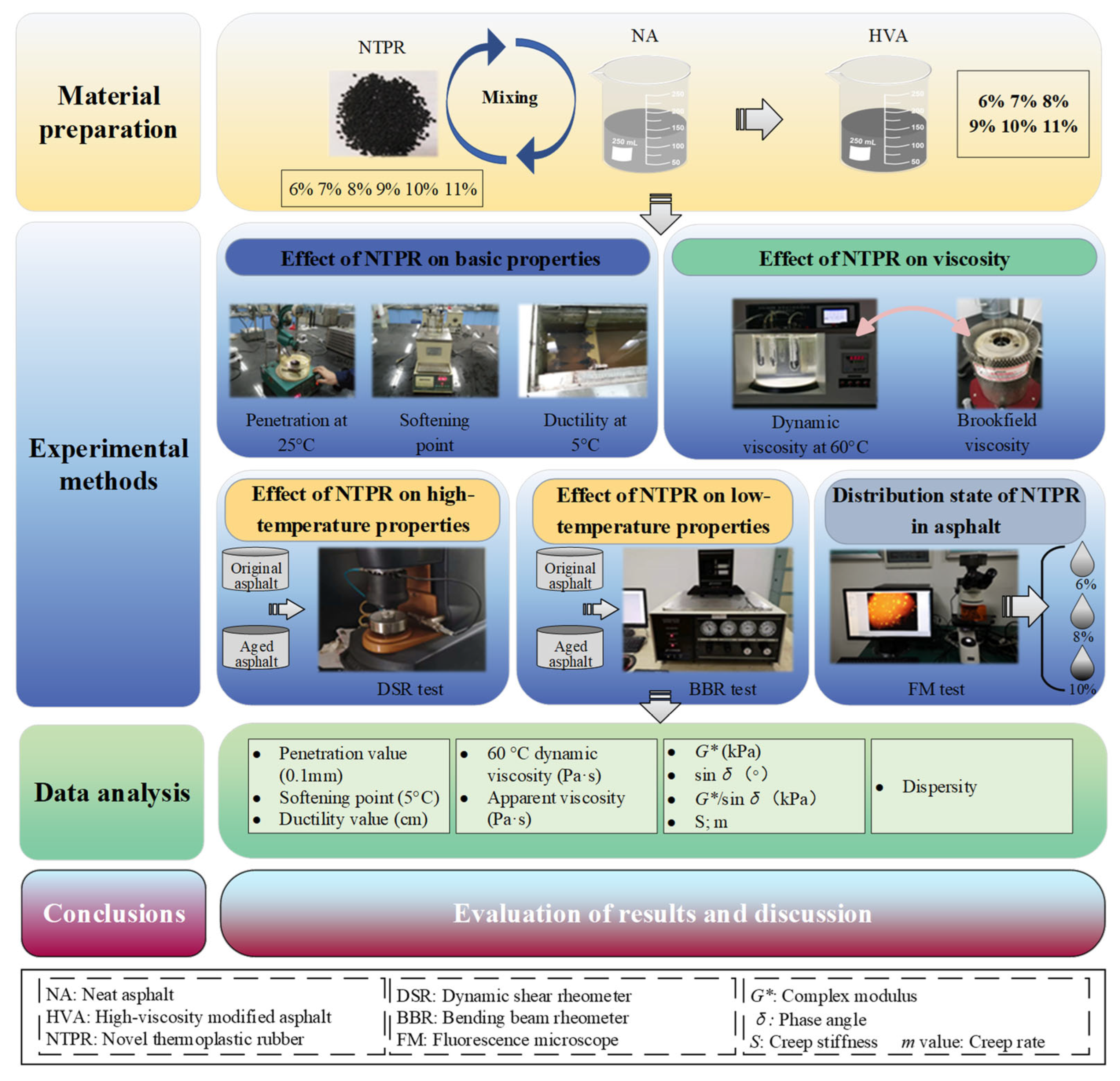


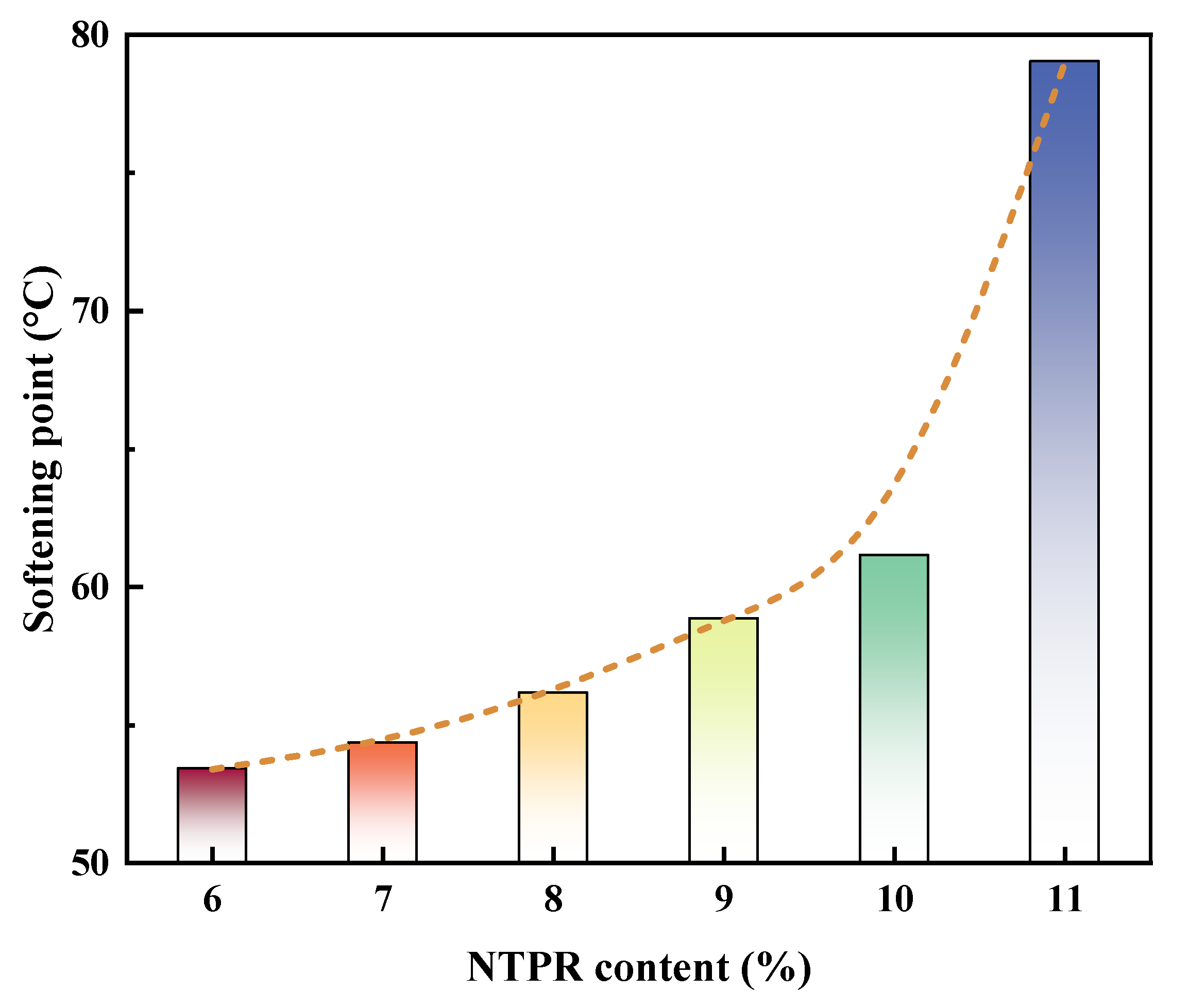
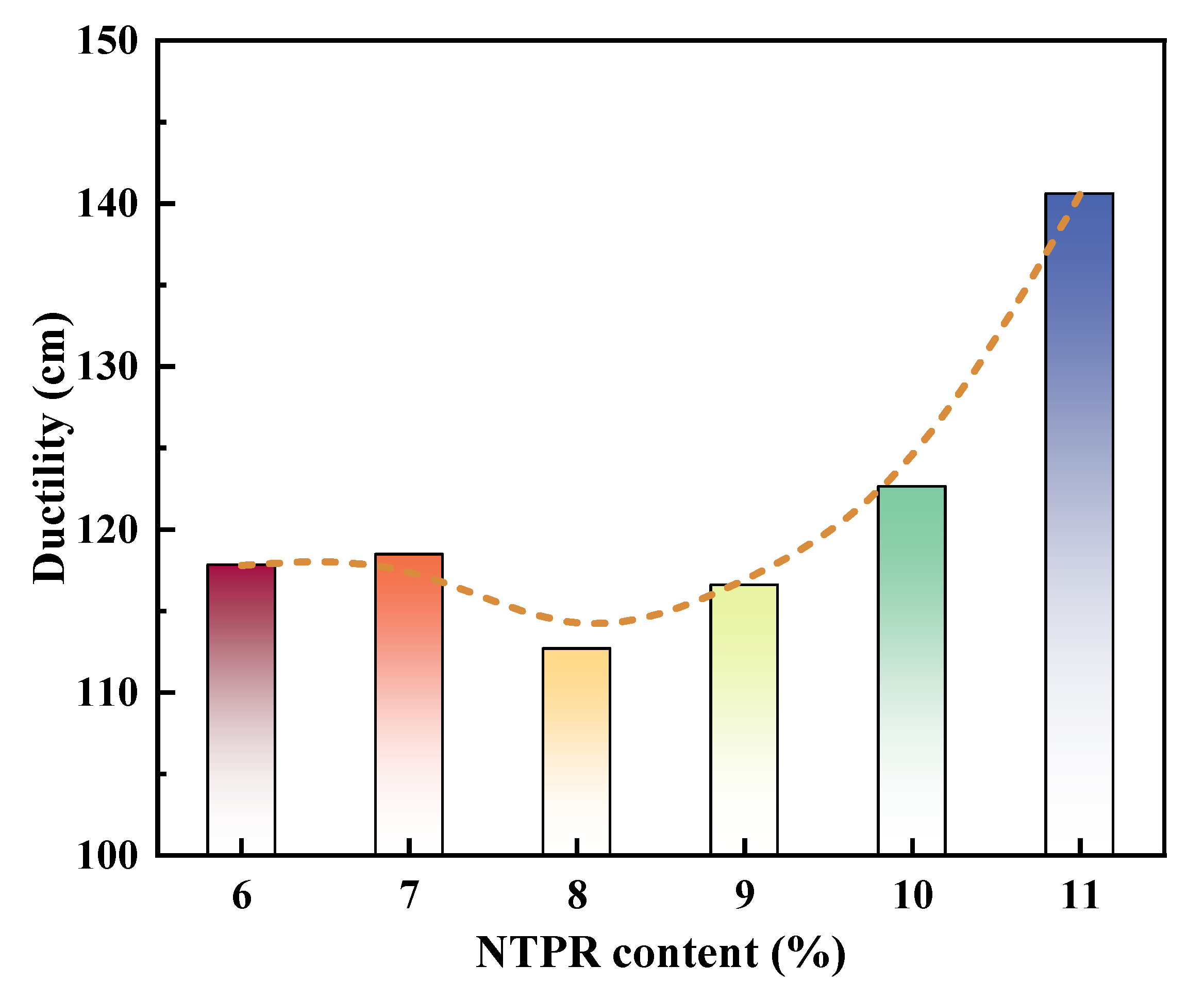
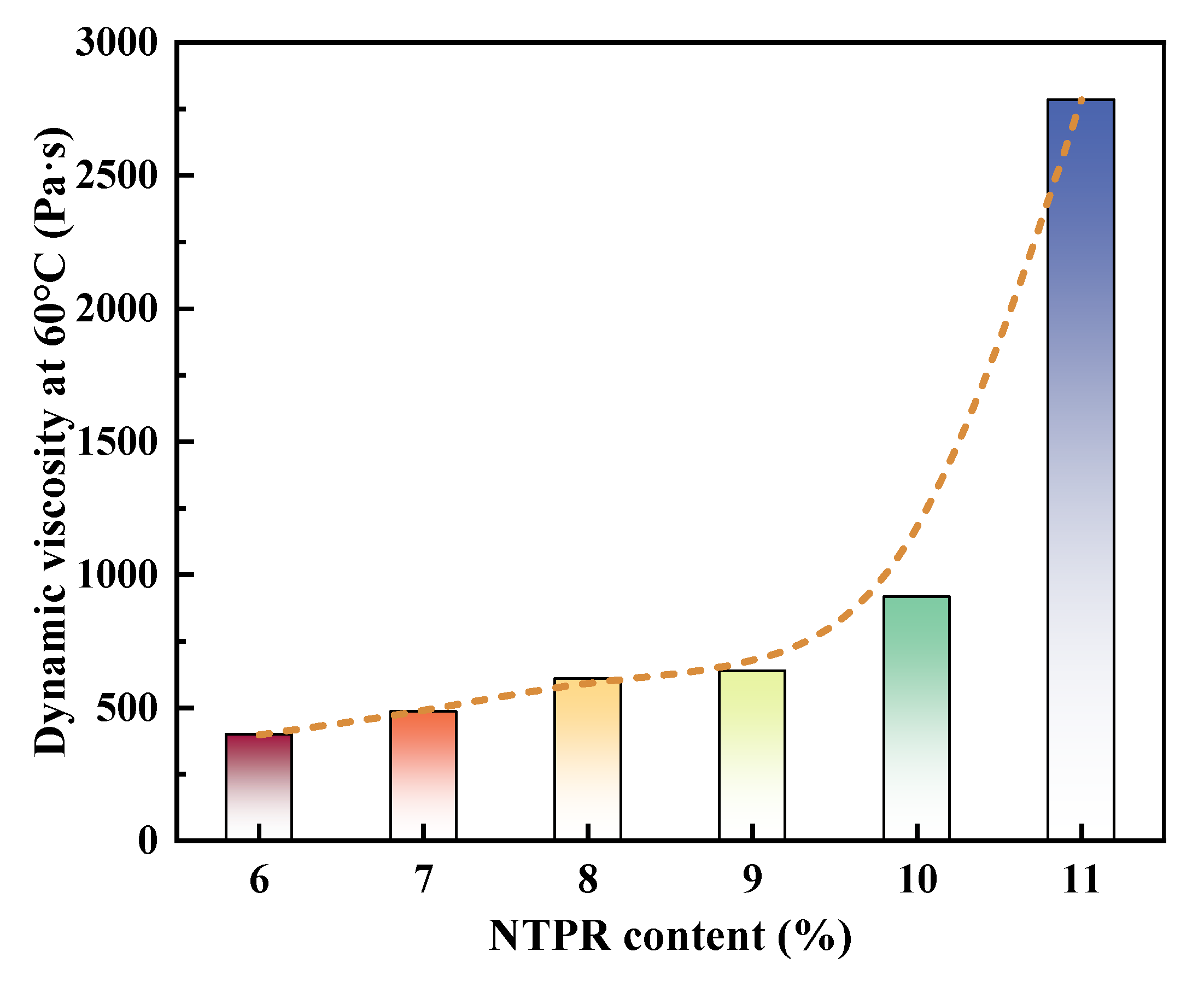


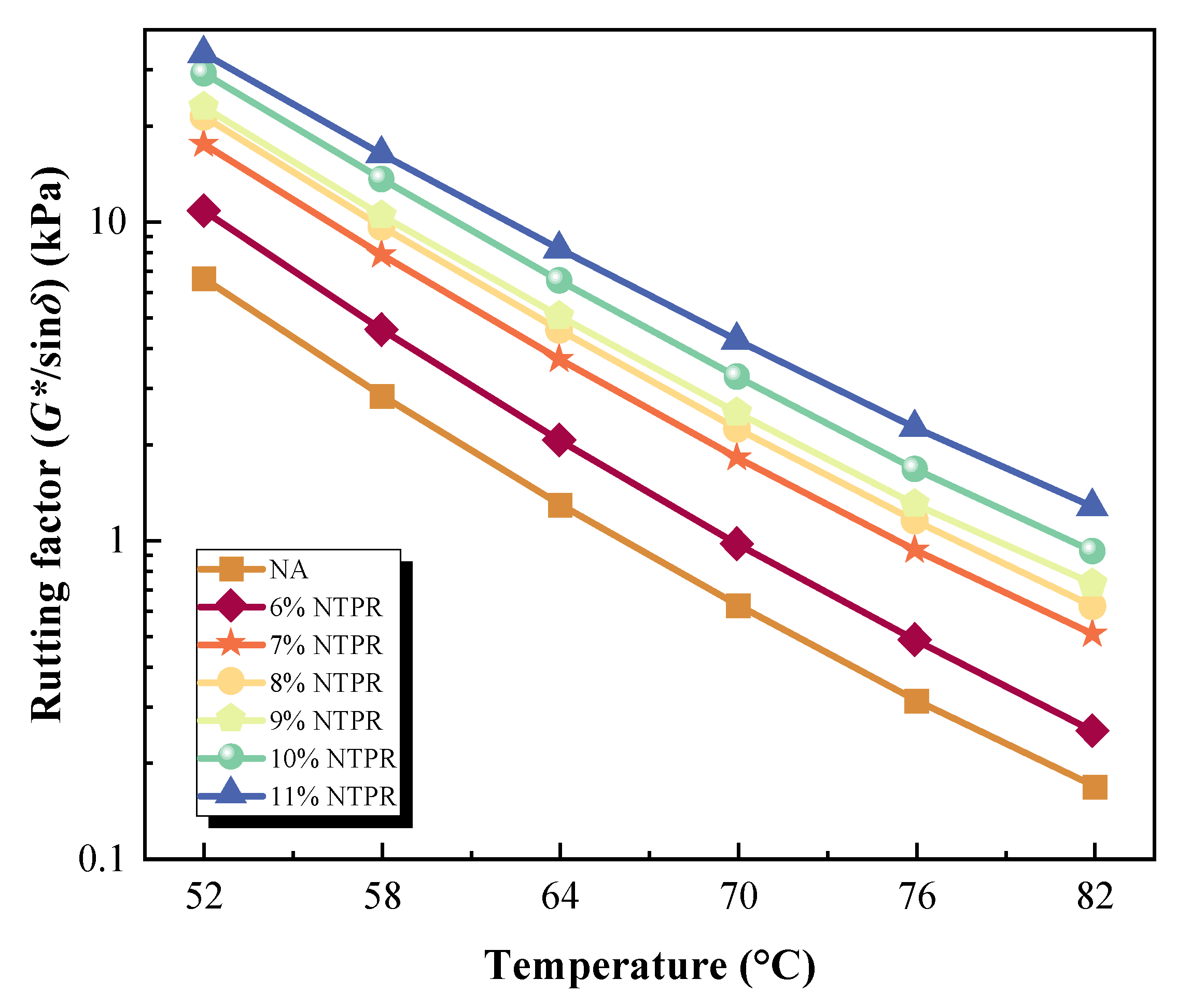
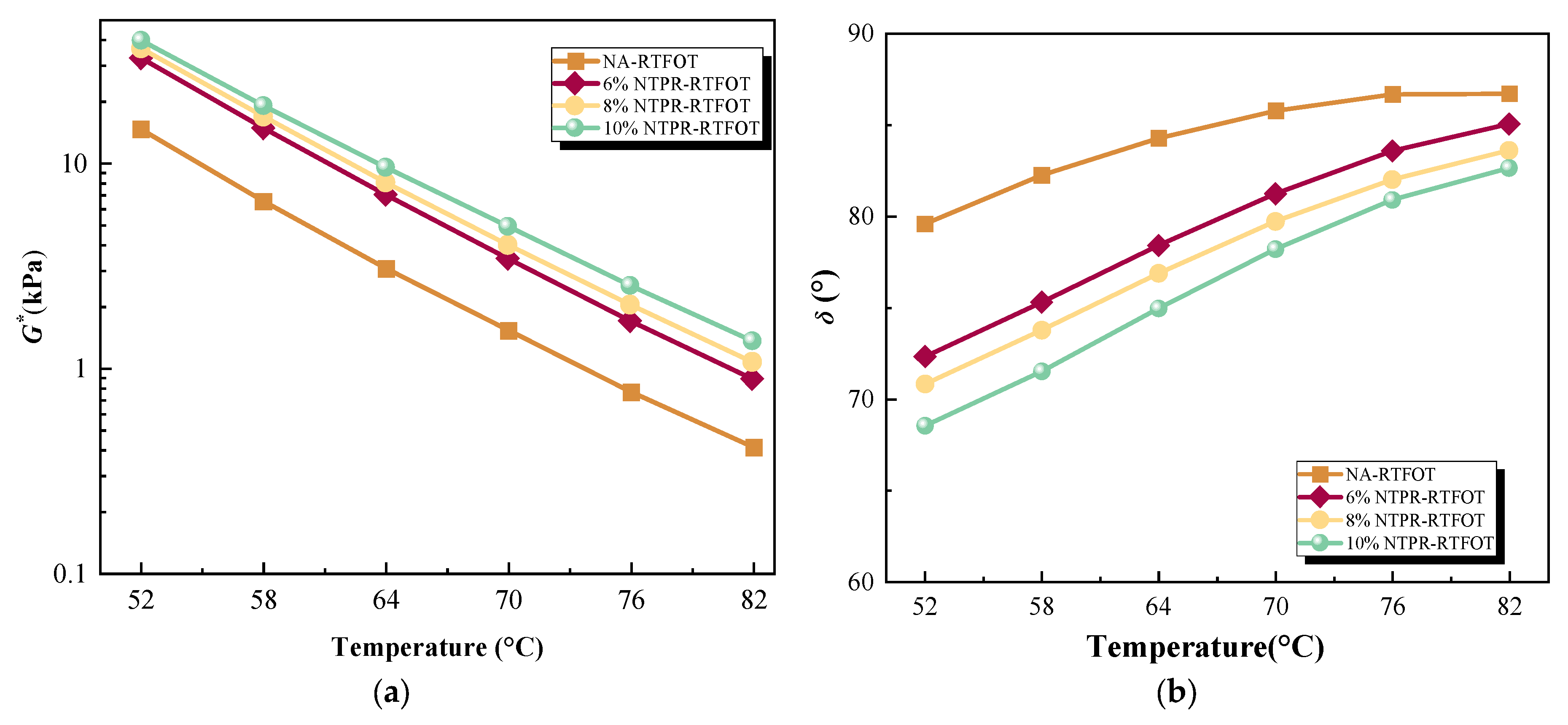
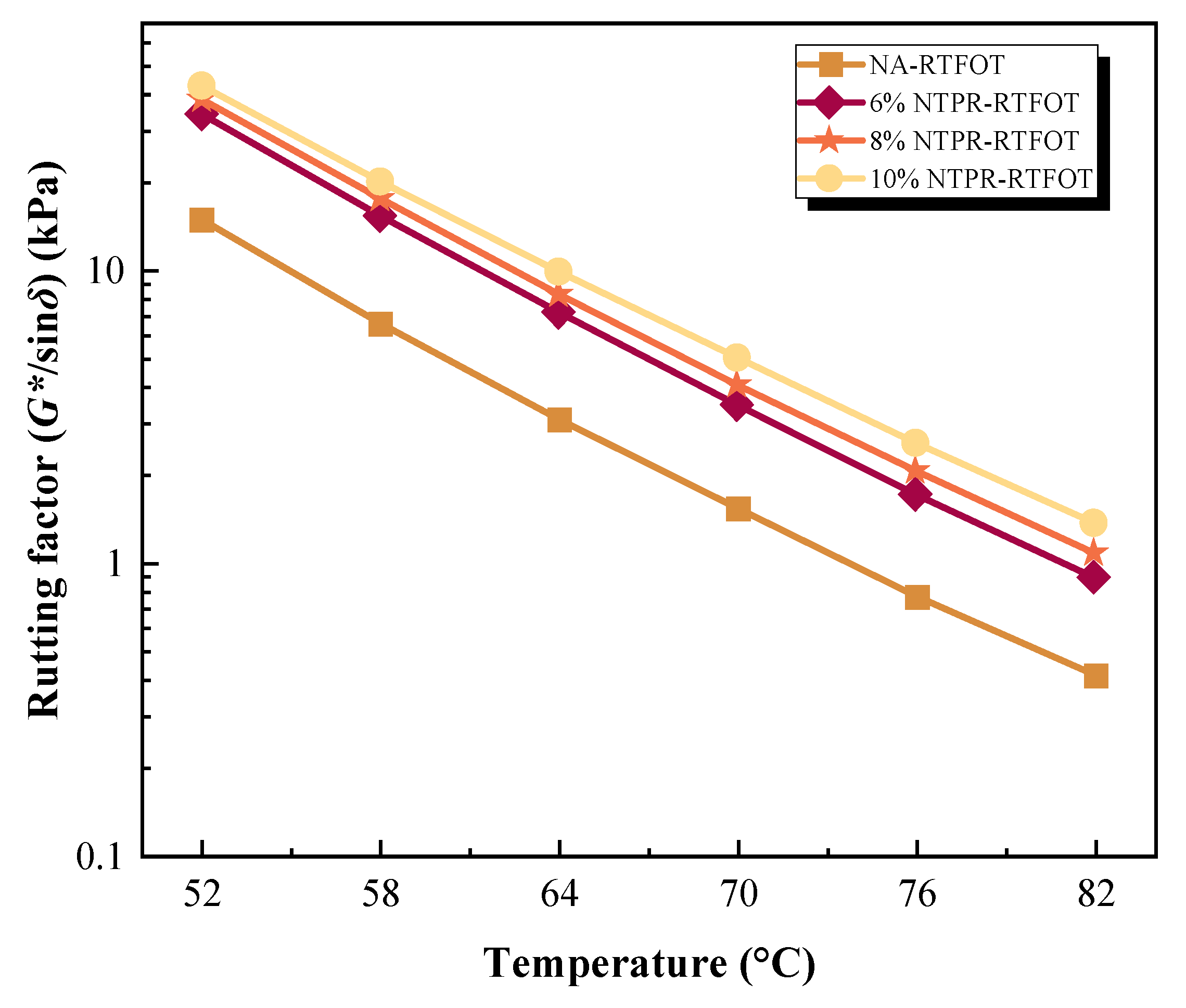
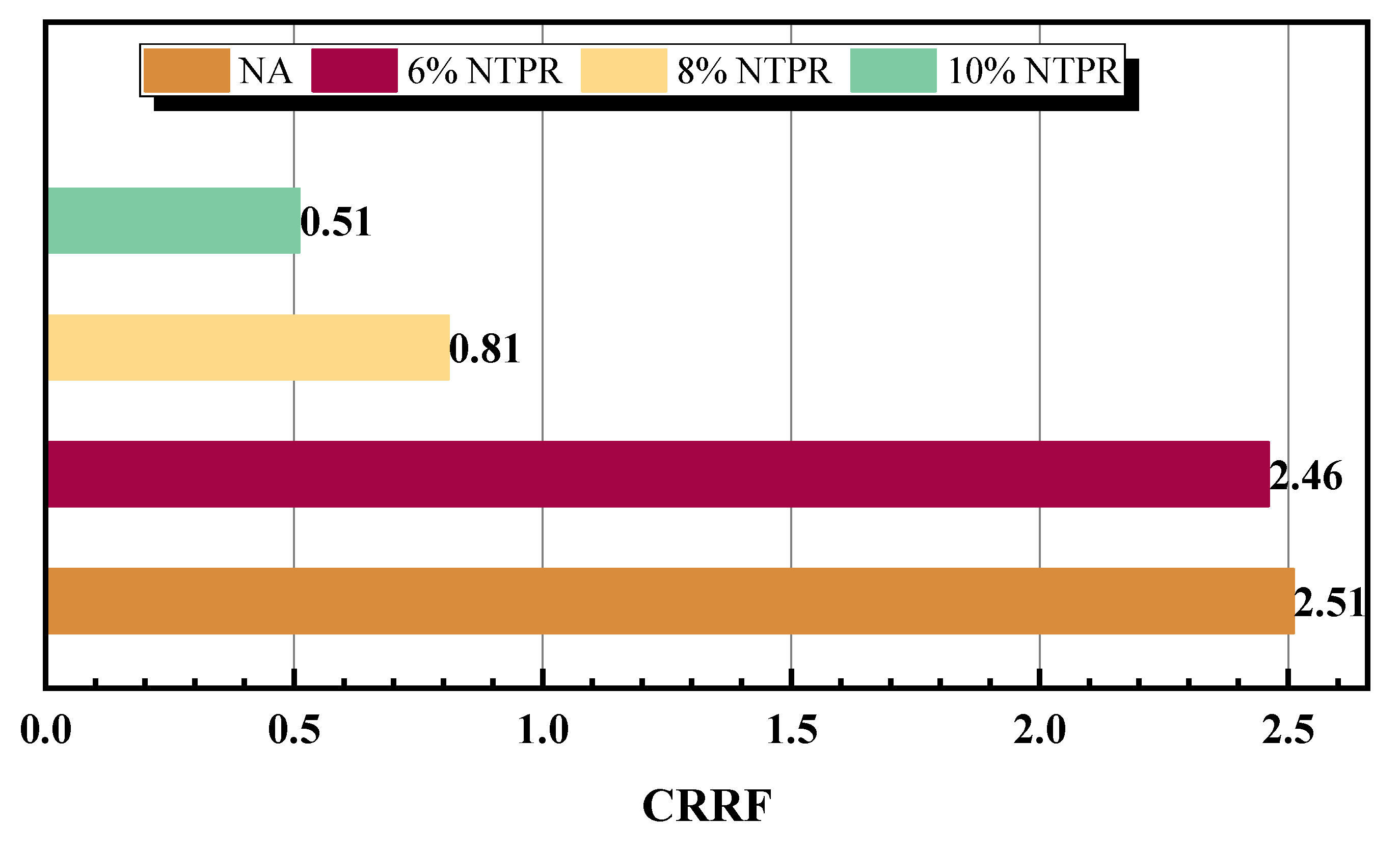
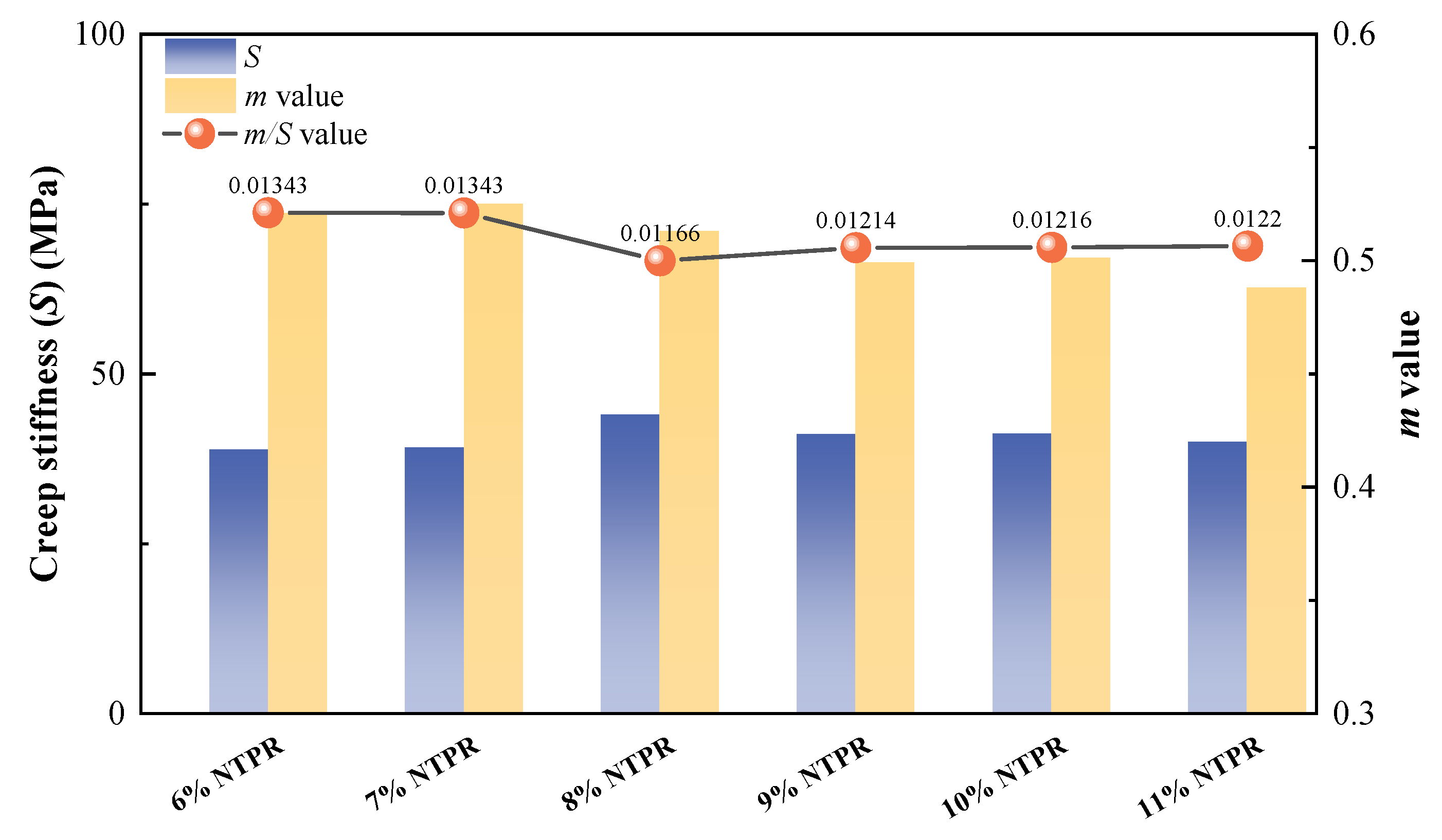
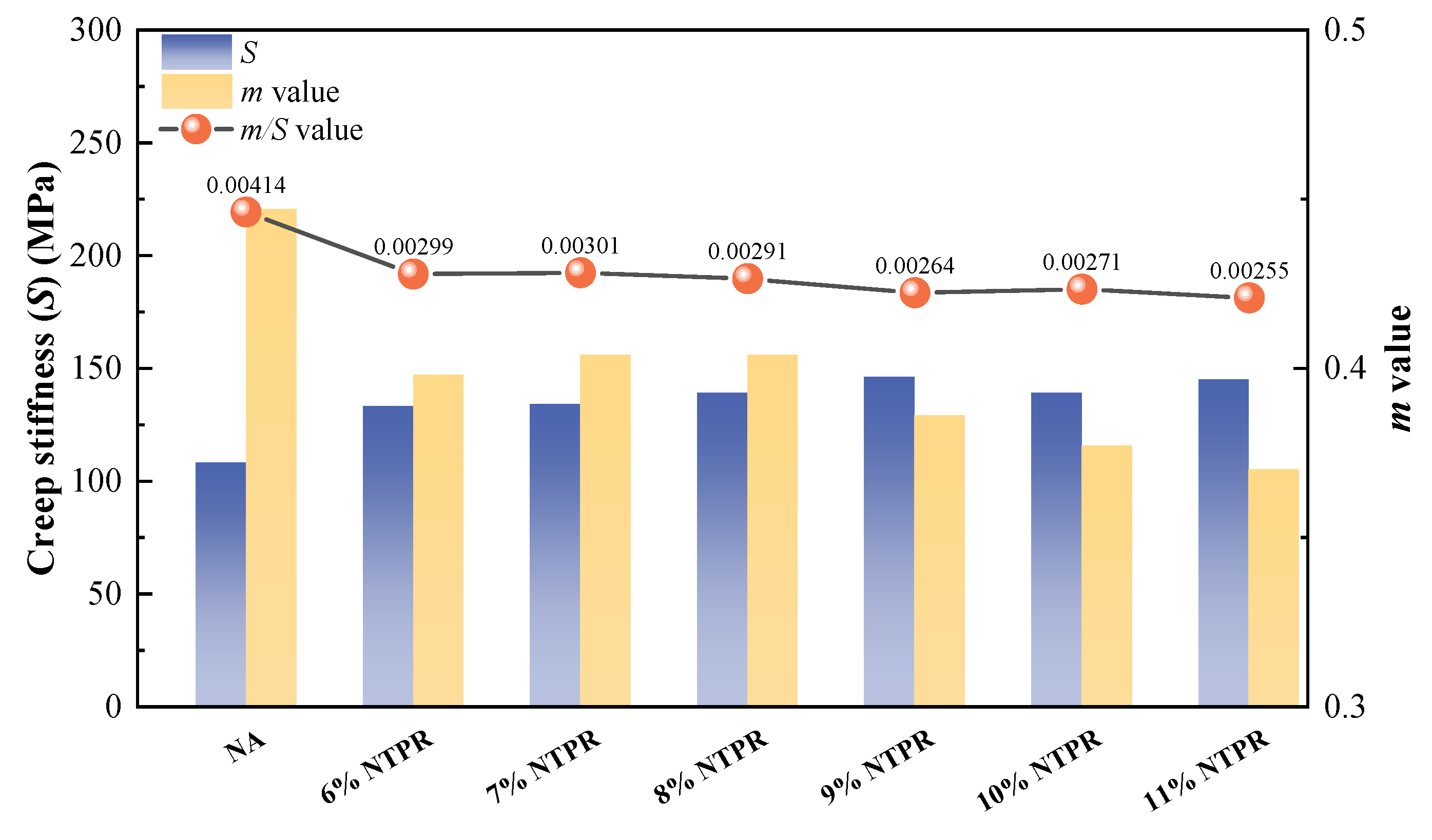
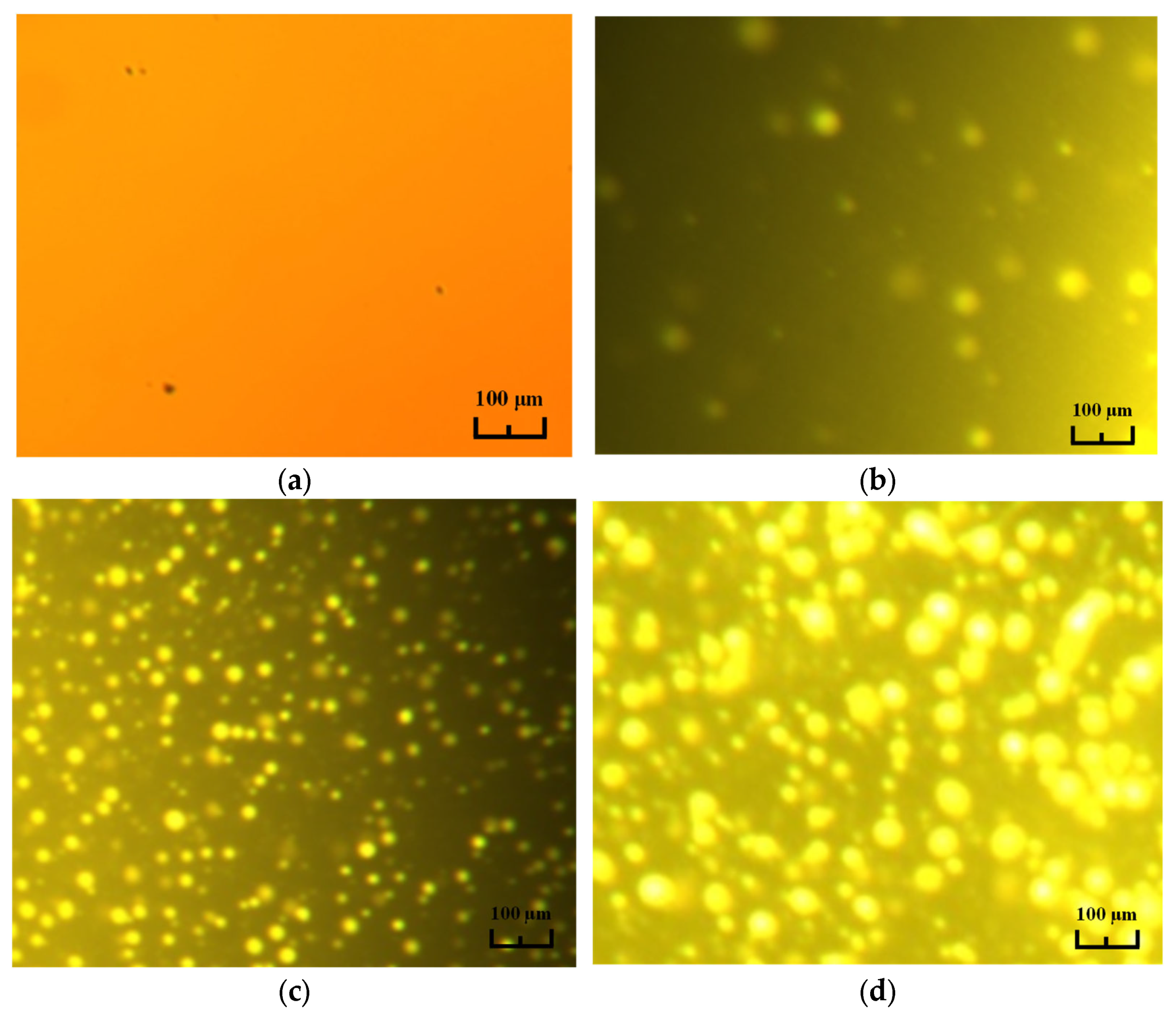
| Technical Index | Measured Value | Indicator Requirement | Test Basis |
|---|---|---|---|
| Penetration (25 °C, 5 s, 100 g) | 72.03 | 60~80 | T0604 |
| Penetration index (PI) | −0.97 | −1.5~+1.0 | T0604 |
| Ductility (5 cm/min, 10 °C, cm) | 72.1 | ≥20 | T0605 |
| Softening point (°C) | 47 | ≥46 | T0606 |
| Dynamic viscosity at 60 °C (Pa·s) | 186 | ≥180 | T0620 |
| Density at 15 °C (g/cm3) | 1.031 | / | T0603 |
| Quality change (%) | 0.09 | ±0.8 | T0610 and T0609 |
| Residual penetration ratio (%) | 71.6 | ≥61 | T0604 |
| Residual ductility at 10 °C (cm) | 8.3 | ≥6 | T0605 |
| Item | Measured Values |
|---|---|
| Particle size (mm) | 2–3 |
| Density (g/cm3) | 0.9 |
| Water absorption (%) | 0.3 |
Disclaimer/Publisher’s Note: The statements, opinions and data contained in all publications are solely those of the individual author(s) and contributor(s) and not of MDPI and/or the editor(s). MDPI and/or the editor(s) disclaim responsibility for any injury to people or property resulting from any ideas, methods, instructions or products referred to in the content. |
© 2023 by the authors. Licensee MDPI, Basel, Switzerland. This article is an open access article distributed under the terms and conditions of the Creative Commons Attribution (CC BY) license (https://creativecommons.org/licenses/by/4.0/).
Share and Cite
Wang, T.; Chen, Z.; Hong, J.; Liao, Z.; Wang, D.; Yuan, D.; Zhang, Y.; Falchetto, A.C. Preparation and Properties of High-Viscosity Modified Asphalt with a Novel Thermoplastic Rubber. Sustainability 2023, 15, 12190. https://doi.org/10.3390/su151612190
Wang T, Chen Z, Hong J, Liao Z, Wang D, Yuan D, Zhang Y, Falchetto AC. Preparation and Properties of High-Viscosity Modified Asphalt with a Novel Thermoplastic Rubber. Sustainability. 2023; 15(16):12190. https://doi.org/10.3390/su151612190
Chicago/Turabian StyleWang, Teng, Zhirong Chen, Jinlong Hong, Zhen Liao, Di Wang, Dongdong Yuan, Yufei Zhang, and Augusto Cannone Falchetto. 2023. "Preparation and Properties of High-Viscosity Modified Asphalt with a Novel Thermoplastic Rubber" Sustainability 15, no. 16: 12190. https://doi.org/10.3390/su151612190
APA StyleWang, T., Chen, Z., Hong, J., Liao, Z., Wang, D., Yuan, D., Zhang, Y., & Falchetto, A. C. (2023). Preparation and Properties of High-Viscosity Modified Asphalt with a Novel Thermoplastic Rubber. Sustainability, 15(16), 12190. https://doi.org/10.3390/su151612190









